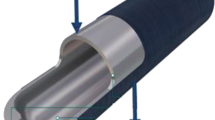A technological specimen representative of type IV high-pressure hydrogen storage vessels is developed. An analytical model is used to compute fiber orientations in the specimen in order to be as representative as possible of the stress level reached in a tank during pressurization. A three-dimensional finite-element model is used to determine the best stacking sequence with these fiber orientations. A validation is done by performing tests with digital image correlation in order to measure displacements on the lateral side of the specimen. A comparison between the calculated and experimentally found strain fields is made. The results obtained highlight the influence of stacking sequence on the development of damage and the difficulty arising in designing representative specimens.










Similar content being viewed by others
References
D. Mori and K. Hirose, “Recent challenges of hydrogen storage technologies for fuel cell vehicles,” Int. J. of Hydrogen Energy, 34, No. 10, 4569-4574 (2009).
S. Satyapal, J. Petrovic, C. Read, G. Thomas, and G. Ordaz, The US Department of Energy’s National Hydrogen Storage Project: “Progress towards meeting hydrogen-powered vehicle requirements,” Catalysis Today, 120 No. 3-4, 246-256 (2007).
O. Comond, D. Perreux, and F. Thiebaud, “Methodology to improve the lifetime of type III HP tank with a steel liner,” Int. J. of Hydrogen Energy, 34, Iss. 7, 3077-3086 (2009).
D. S. Son and S. H. Chang, “Evaluation of modeling techniques for a type III hydrogen pressure vessel (70 MPa) made of an aluminum liner and a thick carbon/epoxy composite for fuel cell vehicles,” Int. J. of Hydrogen Energy, 37, 2353-2369 (2012).
J. H. Hong, M. G. Han, and S. H. Chang, “Safety evaluation of 70 MPa-capacity type III hydrogen pressure vessel considering material degradation of composites due to temperature rise,” Compos. Struct., 113, 127-133 (2014).
B. Gentilleau, M. Bertin, F. Touchard, and J.-C. Grandidier, “Stress analysis in specimens made of multi-layer polymer/ composite used for hydrogen storage application: comparison with experimental results,” Compos. Struct., 93, No. 11, 2760-2767 (2011).
J. P. B. Ramirez, D. Halm, and J.-C. Grandidier, “Deterministic vs Probabilistic Burst Prediction of Wound Composite Pressure Vessel,” http://apps.webofknowledge.com.gate6.inist.fr/full_record.do?product=WOS&search_mode=GeneralSearch&qid=3&SID=R1MkXxtWjZfS5mIELN8&page=1&doc=29th Int. Conf. on Composite Science and Technology, Naples, Italy, pp. 125-135 (2013).
C. J. B. Dicken and W. Merida, “Measured effects of filling time and initial mass on the temperature distribution within a hydrogen cylinder during refueling,” J. of Power Sources, 165, No. 1, 324-336 (2007).
E. Werlen, P. Pisot, K. Barral, and P. Renault, “Thermal effects related to H2 fast filling in high pressure vessels depending on vessels types and filling procedures: modelling, trials and studies,” Eur. Energy Conf. (2003).
M. Bertin, F. Touchard, and M. C. Lafarie-Frenot, “Experimental study of the stacking sequence effect on polymer/ composite multi-layers submitted to thermomechanical cyclic loadings,” Int. J. of Hydrogen Energy, 35, No. 20, 11397-11404 (2010).
J.-M. Berthelot, Composite Materials: Mechanical Behaviour and Structural Analysis, Ed. Masson (1999).
B. Gentilleau, F. Touchard, and J.-C. Grandidier, “Numerical study of influence of temperature and matrix cracking on type IV hydrogen high pressure storage vessel behaviour,” Compos. Struct., 111, 98-110 (2014).
J. H. Kim, M. G. Lee, K. Chung, J. R. Youn, and T. J. Kang, “Anisotropic-asymmetric yield criterion and anisotropic hardening law for composite materials. Theory and formulations,” Fibers and Polymers, 7, No. 1, 42-50 (2006).
A. C. Orifici, I. Herszberg, and R. S. Thomson “Review of methodologies for composite material modelling incorporating failure,” Compos. Struct., 86, Iss. 1–3, 194-210 (2008).
H. Zhang, Y. Liu, and B. Xu, “Plastic limit analysis of ductile composite structures from micro- to macro-mechanical analysis,” Acta Mechanica Solida Sinica, 22, Iss. 1, 73-84 (2009).
P. F. Liu and J. Y. Zheng, “Recent developments on damage modeling and finite element analysis for composite laminates: A review,” Materials & Design, 31, Iss. 8, 3825-3834 (2010).
K. A. Acton, “Modeling elasto-plastic composite material behavior by meso-scale homogenization,” PhD thesis, J. Hopkins Univ., Ed. ProQuest, USA (2009).
W. H. Peters and W. F. Ranson, “Digital imaging techniques in experimental stress-analysis,” Optical Engineering, 21, 3, 427-431 (1982).
M. A. Sutton, A. K. Wong, and Y. J. Chao, “Enhanced displacement measurement using a generalized formulation for double-aperture specklegrams,” Experimental Mechanics, 23, 3, 348-53 (1983).
C. Qian, L. T. Harper, T. A. Turner, and N. A. Warrior, “Notched behaviour of discontinuous carbon fiber composites: Comparison with quasi-isotropic non-crimp fabric,” Composites: Part A, Appl. Sci. and Manufact., 42, No. 3, 293-302 (2011).
D. S. Yang, M. Bornert, S. Chanchole, L. L. Wang, P. Valli, and B. Gatmiri, “Experimental investigation of the delayed behaviour of unsaturated argillaceous rocks by means of digital image correlation techniques,” Appl. Clay Sci., 54, No. 1, 53-62 (2011).
J. Dautriat, M. Bornert, N. Gland, A. Dimanov, and J. Raphanel, “Localized deformation induced by heterogeneities in porous carbonate analysed by multi-scale digital image correlation,” Tectonophysics, 503, No. 1-2, 100-116 (2011).
M. Bornert, F. Vales, H. Gharbi, and D. N. Minh, “Multiscale full-field strain measurements for micromechanical investigations of the hydromechanical behaviour of clayey rocks,” Strain, 46, No. 1, 33-46 (2010).
F. Lagattu-Touchard, F. Bridier, P. Villechaise, and J. Brillaud, “In-plane strain measurements on a microscopic scale by coupling digital image correlation and an in-situ SEM technique,” Materials Characterization, 56, 10-18 (2006).
C. Bonnafous, D. Vasconcellos, F. Touchard, and L. Chocinski-Arnault, “Experimental and numerical investigation of the interface between epoxy matrix and hemp yarn,” Composites: Part A, 43, 2046–2058 (2012).
J. Brillaud and F. Lagattu-Touchard, “Limits and possibilities of laser speckle and white-light image-correlation methods. Theory and experiments,” Applied Optics, 41, 31, 6603-6613 (2002).
Acknowledgements
We express our thanks to the partners of H2E OSEO innovation project and to the partners of HyBou project.
Author information
Authors and Affiliations
Corresponding author
Additional information
Russian translation published in Mekhanika Kompozitnykh Materialov, Vol. 51, No. 4, pp. 661-678 , July-August, 2015.
Rights and permissions
About this article
Cite this article
Gentilleau, B., Touchard, F., Grandidier, JC. et al. Numerical Determination and Experimental Validation of a Technological Specimen Representative of High-Pressure Hydrogen Storage Vessels. Mech Compos Mater 51, 465–478 (2015). https://doi.org/10.1007/s11029-015-9518-3
Received:
Revised:
Published:
Issue Date:
DOI: https://doi.org/10.1007/s11029-015-9518-3




